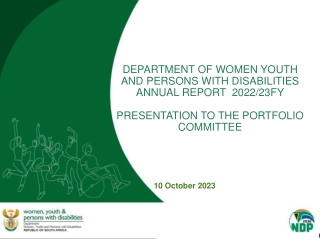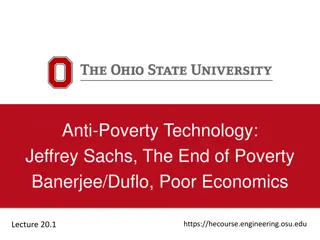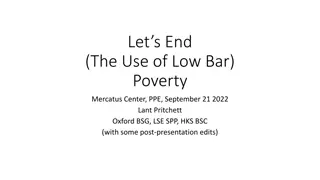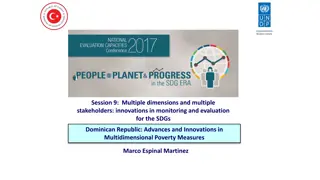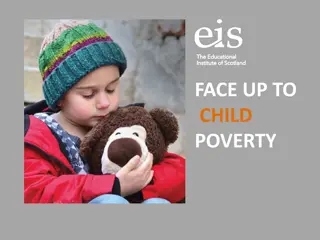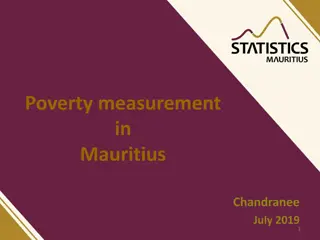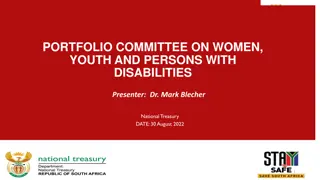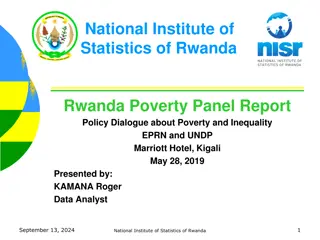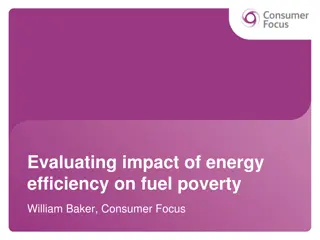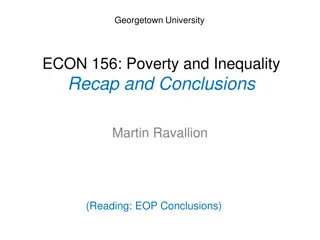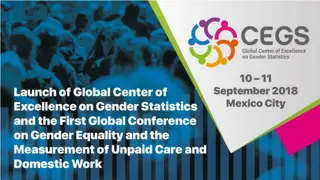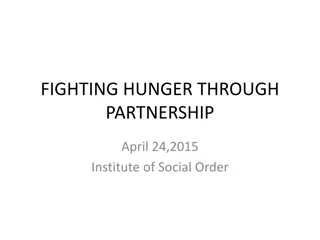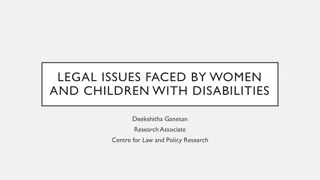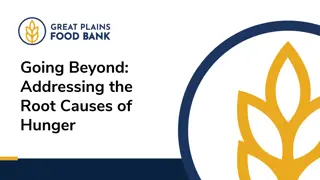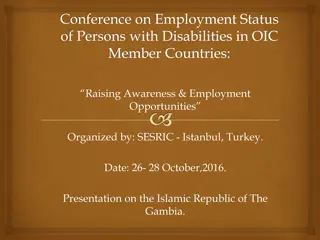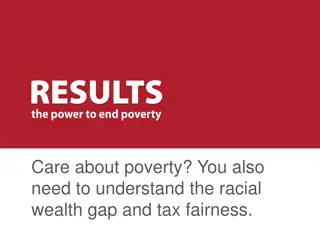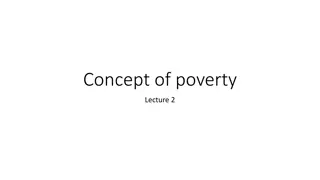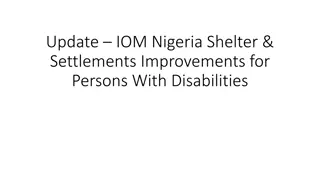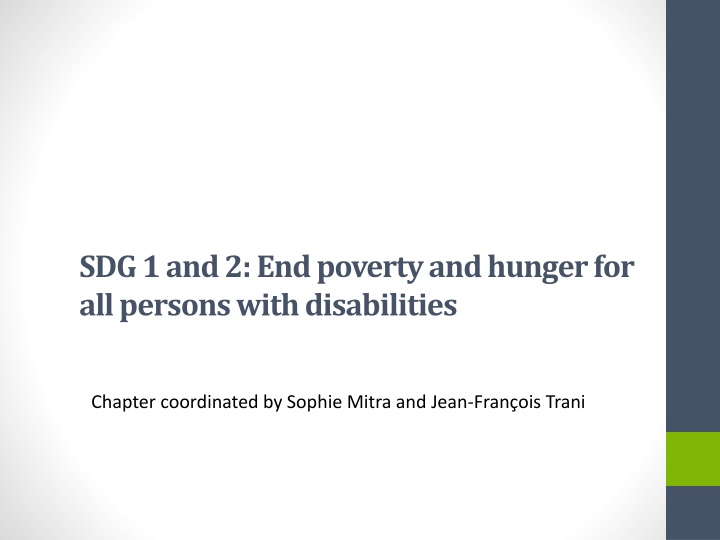
Addressing Poverty and Hunger for Persons with Disabilities
The Sustainable Development Goals emphasize the need to end poverty and hunger for individuals with disabilities. This chapter discusses the links between disability, poverty, and hunger, highlighting the importance of social protection and non-discrimination. The evidence presented sheds light on the challenges faced by persons with disabilities in accessing adequate living standards, food security, and economic opportunities, necessitating targeted policy interventions to ensure their well-being and inclusion.
Download Presentation

Please find below an Image/Link to download the presentation.
The content on the website is provided AS IS for your information and personal use only. It may not be sold, licensed, or shared on other websites without obtaining consent from the author. If you encounter any issues during the download, it is possible that the publisher has removed the file from their server.
You are allowed to download the files provided on this website for personal or commercial use, subject to the condition that they are used lawfully. All files are the property of their respective owners.
The content on the website is provided AS IS for your information and personal use only. It may not be sold, licensed, or shared on other websites without obtaining consent from the author.
E N D
Presentation Transcript
SDG 1 and 2: End poverty and hunger for all persons with disabilities Chapter coordinated by Sophie Mitra and Jean-Fran ois Trani
Introduction 2030 Agenda for Sustainable Development includes two Sustainable Development Goals (SDGs) related to poverty and hunger: SDG 1 to end poverty in all its forms and SDG 2 to achieve zero hunger . The international human rights framework contains a number of provisions ensuring the right to social protection of persons with disabilities. - The Universal Declaration of Human Rights, 1948; - the International Covenant on Economic, Social and Cultural Rights, 1966, - the Convention on the Rights of Persons with Disabilities (CRPD) provides explicit guarantees.
Introduction (Cont.) UNCRPD Art. 28: States Parties recognize the right of persons with disabilities to an adequate standard of living for themselves and their families, including adequate food, clothing and housing, and to the continuous improvement of living conditions, and shall take appropriate steps to safeguard and promote the realization of this right without discrimination on the basis of disability. It also provides for the right to social protection and to the enjoyment of that right without discrimination on the basis of disability and state parties shall take appropriate steps to safeguard and promote the realization of this right>
Section 1: Poverty and hunger situation of persons with disabilities 1.a Links between disability and poverty Vicious cycle: - Poverty may lead to disability through hunger and malnutrition, a lack of access to health care or poor living conditions. - Disability may lead to lower living standards, poverty and hunger through adverse impact on education, employment, earnings, increased expenditures related to disability and a lack of participation in livelihood and other social programs. There could be factors that independently determine both disability and poverty such as violence and conflict, inadequate health care services, limited infrastructure.
Section 1: Poverty and hunger situation of persons with disabilities (Cont.) 1.b Evidence on the association of disability and poverty/socioeconomic gradient in disability: There has been growing evidence on their association: persons with disabilities, and their households, are more likely to live in poverty. Hunger: evidence has recently emerged that persons with disabilities are more likely to live in food insecure households (Brucker 2016; Mitra 2017). Income poverty: a lot of the evidence on the higher poverty rate among persons with disabilities pertains to HICs (Brucker et al 2015; Grammenos 2013; She and Livermore 2009). Assets and living conditions: No consistent result Yes: Bernabe-Ortiz et al (2017); Hosseinpoor et al (2013); Kuper et al (2016). No: Eide et al (2003a), Trani and Loeb (2010).
Section 1: Poverty and hunger situation of persons with disabilities (Cont.) Household expenditures: No consistent result Yes: Hoogeveen (2005) (Uganda), Mont & Cuong (2011) (Vietnam). No: Mitra et al (2013) The expenditure metric is problematic given extra expenditures associated with disability. The case study of Vietnam (Mont and Nguyen 2017): - 17.2% of the population with a disability was poor compared to 15.1% of the non-disabled population, revealing a modest poverty gap. - When the poverty line was adjusted for estimates of extra costs associated with disability, the poverty rate for people with disabilities rose to 22.6%.
Section 1: Poverty and hunger situation of persons with disabilities (Cont.)
Section 1: Poverty and hunger situation of persons with disabilities (Cont.) Multidimensional poverty: Recently, poverty has increasingly been understood more broadly in terms of disadvantage in various dimensions of well-being (Sen 1999; UNDP 2010), as reflected in SDG 1 with poverty in all its forms . Several recent studies have found disability is associated with a higher likelihood of experiencing multiple deprivations, also referred to as multidimensional poverty (Brucker et al 2015; Mitra et al 2013; Mitra 2017; Trani et al 2013; 2013; 2015, 2016). disability is correlated with the experience of multidimensional poverty while the very nature of deprivations may vary across countries (e.g. non-employment, low educational attainment, social isolation, poor psychological well-being). This growing literature has provided consistent evidence that
Section 1: Poverty and hunger situation of persons with disabilities (Cont.)
Section 1: Poverty and hunger situation of persons with disabilities (Cont.) 1.b Recommendations: A growing body of research studies shows that persons with disabilities and their families tend to be more often subject to hunger and poverty. Global and country indicators of hunger and poverty are typically not disaggregated by household or individual disability status. Hunger and poverty statistics such as the $1.90 a day, the MPI and SDG indicators on poverty and hunger should be disaggregated based on disability status. It is therefore necessary that internationally comparable disability indicators become standard in household surveys, censuses, as well as in the monitoring systems of NGOs and governments, to make this disaggregation possible and to inform the development of disability-inclusive policies and programmes.
Section 2: Social Protection Policies and Programs Definition: Social protection is defined broadly and refers to preventing, managing and overcoming situations that adversely affect a person or a household s wellbeing. The programs that explicitly address the needs of persons with disabilities in relation to poverty and hunger are the focus of the rest of this chapter, including: income supports, programs that actively support their livelihoods (e.g. community based rehabilitation programs) and national disability-specific and mainstream programs.
Section 2: Social Protection Policies and Programs (Cont.) 2.a Community Based Rehabilitation (CBR) programmes Background: CBR should promote the rights of people with disabilities to live as equal citizens within the community, to enjoy health and well-being, to participate fully in educational, social, cultural, religious, economic and political activities (ILO UNESCO & WHO 2004). In practice, health, rehabilitation and social services are often delivered by governmental and non-governmental organizations with limited involvement of families, disabled people organizations (DPOs) or persons with disabilities themselves (Turmusani, Vreede et al. 2002). CBR are in place in approximately 100 countries around the world but only a minority of persons with disabilities have access to their services (WHO-World Bank 2011).
Section 2: Social Protection Policies and Programs (Cont.) 2.a Community Based Rehabilitation (CBR) programmes (Cont.) If they are actually effective, there is a strong need for scaling up. Yet, to date, evaluation of their impact on various outcomes such as functioning, social participation and multiple dimensions of wellbeing of persons with disabilities and their caregivers remain limited. India: Mauro et al. (2015) showed that deprived persons with disabilities experienced an improvement in health, income or employment, inclusion in family and community life after 4 years and 7 years of CBR participation. Indicators of inclusion keep increasing in the long run and have a spillover effect on those persons with disabilities who chose not to participate in the CBR program but living in its catchment area, illustrating the complex pattern of sensitization and awareness processes in a given community. Afghanistan: Trani et al. (2017) showed significant improvements on five dimensions of well-being - mobility, activities of daily living, communication, participation in social and community life, and emotional wellbeing - after 2 to 3 years of participation in a CBR program.
Section 2: Social Protection Policies and Programs (Cont.) 2.a Community Based Rehabilitation (CBR) programmes (Cont.) Existing studies, while scarce, overall tend to indicate that CBR programs might successfully address some of the direst needs of participants with disabilities. Yet, they also point to some shortcomings and necessary changes. To enhance their impact, CBR programs may benefit from a more systematic and standardized way of providing services, including rigorous monitoring. Currently, studies show that each CBR worker might implement their own vision of the programme process. Recommendations: Rigorous process and impact evaluations are required to better target limited resources and inform potential replications elsewhere or scale-up successful programs. Advocacy and awareness activities should be integral to CBR programs as they are essential to promote the social inclusion of participants. In addition, there is a need to stick to the original vision of the World Health Organization of a program defined and implemented with the participation of those it serves. Finally, to meet the Sustainable Development Goals' call to leave no one behind , CBR programs could be leveraged to include persons with disabilities in livelihood and social protection initiatives.
Section 2: Social Protection Policies and Programs (Cont.) 2.b. Social protection programs targeted at persons with disabilities The big picture: Almost all countries have contributory disability benefit programs that protect persons who have made contributions over a qualifying period while working in the formal economy. About 80 countries have non-contributory (also called tax financed) disability benefit programs. Personal independent payment benefits are to address the extra costs of living with a disability. They are very rare. Disability pensions for the working age population (contributory or not) are the most common type of disability benefit programs (ILO 2014). In some high-income countries, they have been found to have employment disincentive effects (OECD 2003) but in an emerging literature, no such effect has been found in LMICs (e.g Mitra 2009). To avoid such disincentive effects, some countries such as Mauritius, do not restrict beneficiaries to be out of the labor force (Kidd et al 2017).
Section 2: Social Protection Policies and Programs (Cont.) 2.b. Social protection programs targeted at persons with disabilities (Cont.) Disability-targeted benefits have been shown to be key in providing economic security and basic needs. Example: India (Chaudhry 2016) Yet, recent studies show that benefit values do not seem to offer an adequate standard of living and pull households out of poverty, especially after taking into account the diverse situations and the extra costs experienced by persons with disabilities (Banks et al 2017; NDSD 2015; Palmer et al 2015). Access to social protection programs, even disability-targeted ones, has been shown to be restricted by a variety of barriers (Banks et al 2017). For instance, a study conducted in the poorest areas of Johannesburg showed that only 41% of the sample of persons with disabilities were receiving the disability grant, although 71% were aware of it (Graham, Moodley et al. 2013). Disability assessment: Generally speaking, countries have relied primarily on an assessment of an inability to work (e.g. United States, United Kingdom), which is difficult to assess. Many countries also rely on medical criteria to determine eligibility for disability targeted programs (at odds with the CRPD).
Section 2: Social Protection Policies and Programs (Cont.) 2.c. Mainstream social protection programs Although the evidence is limited, countries with disability-specific and old age pension schemes tend to have higher levels of coverage of persons with disabilities compared to countries that have mainstream and household-based transfer schemes (Kidd 2017). There is very little evidence on the coverage of persons with disabilities by mainstream social protection schemes given very seldom research on this topic and given that data is rarely disaggregated by disability status. Recent studies show that although the need for social protection programs tends to be higher among people with disabilities compared to the general population, in several districts of Tanzania and Peru, this was not matched by higher enrolment (Kupper et al (2016); Bernabe-Ortiz et al 2016). It should be noted that faced with little support from social protection programs in LMICs, persons with disabilities often rely on the support of their family.
Section 2: Social Protection Policies and Programs (Cont.) 2.d.Recommendations 1. There is a need to identify and remove the barriers to social protection programs, both mainstream and disability-specific ones. Barriers are in the broader environment (e.g. transportation, negative attitudes) and in the institutions that administer the programs (e.g. information about programs in accessible formats, application processes). 2. The adequacy of benefits also needs to be assessed and improved so that social protection programs can pull persons with disabilities out of poverty. 3. All social protection programs should bemonitored and evaluated for their ability to include, and positively impact, persons with disabilities.
Section 2: Social Protection Policies and Programs (Cont.) 2.d.Recommendations 4. Disability-specific schemes are important in order to effectively address disability-related additional costs (assistive devices, personal care, rehabilitation) and promote greater participation, autonomy and choice of persons with disabilities. They should not impede employment: Social protection policies should be designed so that they protect the rights of those who are not able to find suitable employment and need an adequate level of income security. At the same time, they need to promote the participation of persons with disabilities in the labour force through linkages to programs that support training and rehabilitation services among others. 5. There is a need to find better ways to assess eligibility for disability benefits, i.e. who is considered disabled in a country and which types of disabilities are included. The disability determination process used for eligibility purposes has to move away from being a strictly medical approach. The medical approach does not take into account the costs incurred due to disabilities not the real impact in participation resulting from acquiring disabilities.
. Section 3: UN activities to promote the achievement of SDG 1 and 2 for persons with disabilities Inputs welcome and needed!
Thankyou! Comments, feedback welcome. mitra@fordham.edu
References Banks L.M., Mearkle, R., Mactaggart, I., Walsham, M., Kuper, H. & Blanchet, K. (2017) Disability and social protection programmes in low- and middle- income countries: a systematic review. Oxford Development Studies 45:3, 223-239, Biggeri, M., S. Deepak, V. Mauro, J. F. Trani, J. Kumar and P. Ramasamy (2014). "Do community-based rehabilitation programmes promote the participation of persons with disabilities? A case control study from Mandya District, in India." Disability and Rehabilitation36(18): 1508-1517. Brucker, D.L. (2016). Food security among young adults with disabilities in the United States: findings from the National Health Interview Survey. Disability and Health, 9(2), pp. 298-305. Chaudhry, V. (2016), Living at the Edge, Disability, Gender, and Neoliberal Debtscapes of Microfinance in India. Affilia: Journal of Women and Social Work, Vol. 31(2) 177-191 Chinchai, P., T. Bunyamark and P. Sirisatayawong (2010). "Effects of caregiver education in stroke rehabilitation on the quality of life of stroke survivors." World Federation of Occupational Therapists Bulletin61(1): 56-63. Dubois, J. L. and J. F. Trani (2009). "Extending the capability paradigm to address the complexity of disability." ALTER European Journal of Disability Research3(3): 192-218. Eldar, R. (2001). "Community-based rehabilitation: Better quality of life for older rural people with disabilities." Journal of Rural Health17(4): 341-344. Finkenfl gel, H., I. Wolffers and R. Huijsman (2005). "The evidence base for community-based rehabilitation: A literature review." International Journal of Rehabilitation Research28(3): 187-201. Gladstone M, Mallewa M, Alusine Jalloh A, Voskuijl W, Postels D, Groce N, Kerac M, and Molyneux E. (2014) Assessment of Neurodisability and Malnutrition in Children in Africa, Seminars in Pediatric Neurology. 21(1): 50-57. Gottlieb CA, Maenner MJ, Cappa C, Durkin MS (2009) Child disability screening, nutrition, and early learning in 18 countries with low and middle incomes: data from the third round of UNICEF's Multiple Indicator Cluster Survey (2005 06), The Lancet, 374(9704):1831-1839. Graham, L., J. Moodley and L. Selipsky (2013). "The disability-poverty nexus and the case for a capabilities approach: evidence from Johannesburg, South Africa." Disability and Society28(3): 324-337. Grammenos , S. (2013). European comparative data on Europe 2020 & People with Disabilities. Final report on behalf of the Academic Network of European Disability Experts (ANED). Grech, S. (2016). Disability and poverty: complex interactions and critical reframings. In Grech, S. and Soldatic, K. (eds) (2016). Disability in the Global South: the Critical Handbook., pp. 217-236 International Perspectives on Social Policy, Administration and Practice. Springer Switzerland. Groce N. 2003. Adolescents and Youth with Disability: Issues and Challenges. International Policy and Programme Review with Recommendations. Washington, DC. The World Bank. Groce N., Challenger E., Kerac M. (2013) Stronger Together: Nutrition-Disability Links and Synergies - Briefing Note. (Nutrition Working Group: Global Partnership for Children with Disabilities). UNICEF: New York. Groce NE., Kerac M., Farkas A., Schultink W., Berman Bieler R. (2013) Inclusive nutrition for children and adults with disabilities, The Lancet. 1(4): e180 e181 Guerrant RL, Ori RB, Moore SR, Ori M and Lima, A. (2008) Malnutrition as an enteric infectious disease with long-term effects on child development, Nutrition Reviews. 66(9): 487-505. Habibzadeh, H., F. Gofranipoor and F. Ahmadi (2007). "A study on the effect of self care plan on activity daily living status in patient with cerebro vascular accident." Journal of Medical Sciences7(1): 126-130. Helander, E., P. Mendis, G. Nelson and A. Goerdt (1989). Training in the Community for People with Disabilities. Geneva, Switzerland, World Health Organization. Iemmi, V., L. Gibson, K. Blanchet, K. Suresh Kumar, S. Rath, S. Hartley, G. V. Murthy, V. Patel, J. Weber and H. Kuper (2015). "Community-based rehabilitation for people with disabilities in low-and middle-income countries: a systematic review." Campbell Systematic Reviews15. ILO (2014). World Social Protection Report 2014/15. Geneva: International Labor Organization. ILO, UNESCO and WHO (2004). Community Based Rehabilitation: A Strategy for Rehabilitation, Equalization of Opportunities, Poverty Reduction and Social Inclusion of People with Disabilities. Joint Position Paper. Geneva, United Nations.
References (Cont.) Lutter CK, Lutter R (2012) Fetal and early childhood undernutrition, mortality, and lifelong health. Science. 337 (6101): 1495-9 Mauro, V., M. Biggeri and L. Grilli (2015). "Does Community-Based Rehabilitation Enhance the Multidimensional Well- Being of Deprived Persons With Disabilities? A Multilevel Impact Evaluation." World Development76: 190-202. Meyer, B.D., & Mok, W.K.C. (2008). Disability, Earnings, Income and Consumption. Working Paper No. 06.10, Harris School of Public Policy Studies, University of Chicago. Mitchell, R. (1999). "Community-based rehabilitation: The generalized model." Disability and Rehabilitation21(10-11): 522-528. Mitchell, R. (1999). "The research base of community-based rehabilitation." Disability & rehabilitation21(10&11): 459- 468. Mitra, S, Palmer, M. Kim, H., Mont, D. and Groce, N. (2017). Extra costs of living with a disability: a review and agenda for future research. Disability and Health. Mitra, S. (2009), Disability Screening and Labor Supply: Evidence from South Africa, American Economic Review Papers and Proceedings, 99(2); pp. 512-516. Mitra, S., (2017). Disability, Health and Human Development. Palgrave MacMillan: New York. In press. Mitra, S., Posarac, A. and Vick, B. (2013). Disability and Poverty in Developing Countries: a Multidimensional Study. World Development Vol. 41; pp.1-18. Mont, D. and Nguyen C. (2017) Spatial Variation in the Poverty Gap Between People With and Without Disabilities: Evidence from Vietnam, Social Indicators Research. DOI 10.1007/s11205-017-1619-z NDSD (2015) Elements of the financial and economic costs of disability to households in South Africa: a pilot study. National Department of Social Development, Republic of South Africa, Pretoria. Noonill, N., S. Sindhu, S. Hanucharurnkul and N. Suwonnaroop (2007). "An integrated approach to coordination of community resources improves health outcomes and satisfaction in care of Thai patients with COPD." Thai Journal of Nursing Research11(2): 118.
References (Cont.) OECD (2003) Transforming Disability Into Ability: Policies To Promote Work And Income Security For Persons With Disabilities, Organisation for Economic Cooperation and Development: Paris Patel, S., Y. Alavi, R. Lindfield and H. Kuper (2013). "The impact of rehabilitative services in the lives of adults and children with disabilities, in low-income and middle-income countries: An assessment of the quality of the evidence." Disability and Rehabilitation35(9): 703-712. Pinilla-Roncancio, M. and Sabina Alkire, S. (2017). How poor are People with Disabilities around the Globe? A Multidimensional Perspective. Research in progress 48a. Oxford: Oxford Poverty and Human Development Initiative (OPHI). Reddihough DS and Collins KJ (2003) The epidemiology and causes of cerebral palsy. Australian Journal of Physiotherapy. 49: 7-12 Robertson, J., E. Emerson, C. Hatton and M. Yasamy (2012). "Efficacy of community based rehabilitation for children with or at significant risk of intellectual disabilities in low and middle income countries: a review." Journal of Applied Research in Intellectual Disabilities25(2): 143-154. Sharma, S. (2007). "Community participation in community-based rehabilitation programmes." Asia Pacific Disability Rehabilitation Journal 18(2): 146-157. Shin, J. Y., N. V. Nhan, S. B. Lee, K. S. Crittenden, M. Flory and H. T. D. Hong (2009). "The Effects of a Home-Based Intervention for Young Children with Intellectual Disabilities in Vietnam." Journal of Intellectual Disability Research53(4): 339-352. Trani JF and Canning TI (2013) Child poverty in an emergency and conflict context: A multidimensional profile and an identification of the poorest children in Western Darfur. World Development 48, 48-70. Trani JF, Biggeri M and Mauro V (2013). The Multidimensionality of Child Poverty: Evidence from Afghanistan. Social Indicators Research, 112:391 416. Trani, J. F., P. Bakhshi and C. Rolland (2011). "Capabilities, Perception of Well-being and Development Effort: Some Evidence from Afghanistan." Oxford Development Studies39(4): 403-426. Trani, J. F., P. Bakhshi and J. Vasquez-Escallon (2017). Home Based Intervention Disability Program: Impact Evaluation Study Final Report. Kabul, Global Research on Inclusion and Disability: 322. Trani, J.F., Kuhlberg J., Cannings T., & Chakkal, D. (2016). Multidimensional poverty in Afghanistan: Who are the poorest of the poor? Oxford Development Studies, 44(2), 220-445. Turmusani, M., A. Vreede and S. L. Wirz (2002). "Some ethical issues in community-based rehabilitation initiatives in developing countries." Disability and Rehabilitation24(10): 558-564. UNDP (2010). Human development report 2010: the real wealth of nations pathways to human development. New York: United Nations Development Programme. UNICEF (2013) The State of the World's Children 2013: Children with Disabilities. UNICEF: New York United Nations (2006). Convention on the rights of persons with disabilities, United Nations. United Nations (2015) Global status on disability and development: Prototype 2015. Department of Economic and Social Affaires. Velema, J. P., B. Ebenso and P. L. Fuzikawa (2008). "Evidence for the effectiveness of rehabilitation-in-the-community programmes." Leprosy Review79(1): 65-82. WHO-World Bank (2011) World Report on Disability. World Health Organisation (WHO): Geneva. World Health Organization (2010). Community-based rehabilitation: CBR Guidelines. Geneva, WHO. World Health Organization and World Bank (2011). World report on disability. Geneva, World Health Organization: 325.

